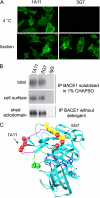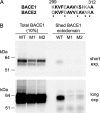Inhibition of beta-secretase in vivo via antibody binding to unique loops (D and F) of BACE1
- PMID: 21209097
- PMCID: PMC3048749
- DOI: 10.1074/jbc.M110.194860
Inhibition of beta-secretase in vivo via antibody binding to unique loops (D and F) of BACE1
Abstract
β-Secretase (BACE1) is an attractive drug target for Alzheimer disease. However, the design of clinical useful inhibitors targeting its active site has been extremely challenging. To identify alternative drug targeting sites we have generated a panel of BACE1 monoclonal antibodies (mAbs) that interfere with BACE1 activity in various assays and determined their binding epitopes. mAb 1A11 inhibited BACE1 in vitro using a large APP sequence based substrate (IC(50) ∼0.76 nm), in primary neurons (EC(50) ∼1.8 nm), and in mouse brain after stereotactic injection. Paradoxically, mAb 1A11 increased BACE1 activity in vitro when a short synthetic peptide was used as substrate, indicating that mAb 1A11 does not occupy the active-site. Epitope mapping revealed that mAb 1A11 binds to adjacent loops D and F, which together with nearby helix A, distinguishes BACE1 from other aspartyl proteases. Interestingly, mutagenesis of loop F and helix A decreased or increased BACE1 activity, identifying them as enzymatic regulatory elements and as potential alternative sites for inhibitor design. In contrast, mAb 5G7 was a potent BACE1 inhibitor in cell-free enzymatic assays (IC(50) ∼0.47 nm) but displayed no inhibitory effect in primary neurons. Its epitope, a surface helix 299-312, is inaccessible in membrane-anchored BACE1. Remarkably, mutagenesis of helix 299-312 strongly reduced BACE1 ectodomain shedding, suggesting that this helix plays a role in BACE1 cellular biology. In conclusion, this study generated highly selective and potent BACE1 inhibitory mAbs, which recognize unique structural and functional elements in BACE1, and uncovered interesting alternative sites on BACE1 that could become targets for drug development.
Figures








Similar articles
-
BACE1 Physiological Functions May Limit Its Use as Therapeutic Target for Alzheimer's Disease.Trends Neurosci. 2016 Mar;39(3):158-169. doi: 10.1016/j.tins.2016.01.003. Epub 2016 Jan 30. Trends Neurosci. 2016. PMID: 26833257 Review.
-
Camelid heavy chain only antibody fragment domain against β-site of amyloid precursor protein cleaving enzyme 1 inhibits β-secretase activity in vitro and in vivo.FEBS J. 2015 Sep;282(18):3618-31. doi: 10.1111/febs.13367. Epub 2015 Jul 22. FEBS J. 2015. PMID: 26147692
-
NFkappaB-dependent control of BACE1 promoter transactivation by Abeta42.J Biol Chem. 2008 Apr 11;283(15):10037-47. doi: 10.1074/jbc.M706579200. Epub 2008 Feb 8. J Biol Chem. 2008. PMID: 18263584
-
Inhibition of BACE1 Activity by a DNA Aptamer in an Alzheimer's Disease Cell Model.PLoS One. 2015 Oct 16;10(10):e0140733. doi: 10.1371/journal.pone.0140733. eCollection 2015. PLoS One. 2015. PMID: 26473367 Free PMC article.
-
BACE1 in Alzheimer's disease.Clin Chim Acta. 2012 Dec 24;414:171-8. doi: 10.1016/j.cca.2012.08.013. Epub 2012 Aug 20. Clin Chim Acta. 2012. PMID: 22926063 Review.
Cited by
-
The Membrane-Bound Aspartyl Protease BACE1: Molecular and Functional Properties in Alzheimer's Disease and Beyond.Front Physiol. 2012 Feb 17;3:8. doi: 10.3389/fphys.2012.00008. eCollection 2012. Front Physiol. 2012. PMID: 22363289 Free PMC article.
-
Generation of highly selective monoclonal antibodies inhibiting a recalcitrant protease using decoy designs.Biotechnol Bioeng. 2020 Dec;117(12):3664-3676. doi: 10.1002/bit.27519. Epub 2020 Aug 6. Biotechnol Bioeng. 2020. PMID: 32716053 Free PMC article.
-
ADP ribosylation factor 6 (ARF6) controls amyloid precursor protein (APP) processing by mediating the endosomal sorting of BACE1.Proc Natl Acad Sci U S A. 2011 Aug 23;108(34):E559-68. doi: 10.1073/pnas.1100745108. Epub 2011 Aug 8. Proc Natl Acad Sci U S A. 2011. PMID: 21825135 Free PMC article.
-
BACE1 Function and Inhibition: Implications of Intervention in the Amyloid Pathway of Alzheimer's Disease Pathology.Molecules. 2017 Oct 13;22(10):1723. doi: 10.3390/molecules22101723. Molecules. 2017. PMID: 29027981 Free PMC article. Review.
-
AAV-mediated delivery of an anti-BACE1 VHH alleviates pathology in an Alzheimer's disease model.EMBO Mol Med. 2022 Apr 7;14(4):e09824. doi: 10.15252/emmm.201809824. Epub 2022 Mar 30. EMBO Mol Med. 2022. PMID: 35352880 Free PMC article.
References
-
- Hardy J., Selkoe D. J. (2002) Science 297, 353–356 - PubMed
-
- Golde T. E., Dickson D., Hutton M. (2006) Curr. Alzheimer Res. 3, 421–430 - PubMed
-
- Selkoe D. J. (2001) Physiol. Rev. 81, 741–766 - PubMed
-
- Hussain I., Powell D., Howlett D. R., Tew D. G., Meek T. D., Chapman C., Gloger I. S., Murphy K. E., Southan C. D., Ryan D. M., Smith T. S., Simmons D. L., Walsh F. S., Dingwall C., Christie G. (1999) Mol. Cell Neurosci. 14, 419–427 - PubMed
-
- Sinha S., Anderson J. P., Barbour R., Basi G. S., Caccavello R., Davis D., Doan M., Dovey H. F., Frigon N., Hong J., Jacobson-Croak K., Jewett N., Keim P., Knops J., Lieberburg I., Power M., Tan H., Tatsuno G., Tung J., Schenk D., Seubert P., Suomensaari S. M., Wang S., Walker D., Zhao J., McConlogue L., John V. (1999) Nature 402, 537–540 - PubMed
Publication types
MeSH terms
Substances
LinkOut - more resources
Full Text Sources
Other Literature Sources

